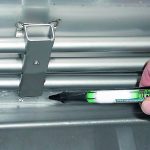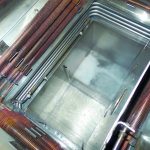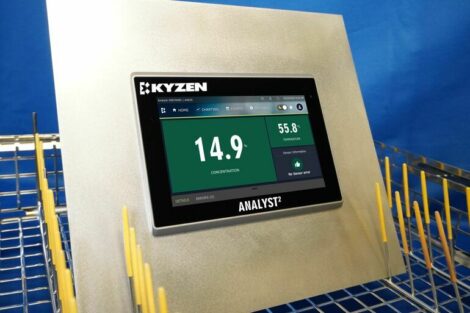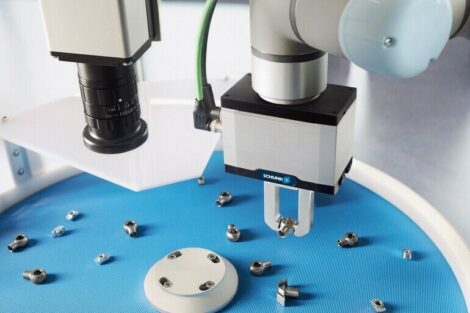2016 is going to become a good year for the electronics industry, however, not all companies are optimistic. One of the primary reasons is the global instability in environmental regulations. The electronics industry is seeing at least six different regulatory conflicts that are raising costs, creating trade barriers, increasing commercial risks, stifling innovation and creating uncertainty. The phase-out of the solvent HCFC-225 is critical for businesses with complex cleaning requirements.
Mike Jones, Vice President, MicroCare Corporation, New Britain, CT; USA
2016 has already been very positive for the electronics industry with estimated global growth rates set to increase. The economies of the US and most of Europe seem to be bouncing back from the most extreme economic downturn since 1929 with Americas seeing a 6 % growth and Europe 4 % in the electronics industry from the previous year. This growth is also seen in Asia with an estimated 6 % growth and Australia, New Zealand and South Africa seeing a 4 % increase (according to Statista). Despite tempered expectations, most forecasters see strong growth ahead. They expect a robust US economy to continue to lead the way, and Draghi’s program of quantitative easing is a sign the EU is ready for expansion. China has experienced broad improvements in macroeconomic conditions, with its economy seeing a 7 % growth this year and 6.3 % in 2016 (reports McKinsey & Company).
Japan is still the powerhouse exporter for electronics and has the third biggest economy. Since Prime Minister Shinzo Abe came to power in 2012 and made a number of substantive changes to economic policies in the country, including softening the value of the yen, Japanese exporters can be significantly more competitive globally. This policy has resulted in a noticeable uptick in economic activity in Nippon. All in all, 2016 is already a very good year for the electronics industry. Nonetheless, many businesses are less than optimistic. One of the primary reasons is the instability in environmental regulations. Taking a global perspective, the electronics industry is seeing at least six different regulatory conflicts that will cause consternation among PCBA makers. These new rules are raising costs and imposing hidden taxes upon businesses, creating trade barriers, increasing commercial risks, stifling innovation and creating an aura of uncertainty that crushes investment.
HCFC-225 phase-out
The phase-out of the last major ozone-depleting solvent, HCFC-225, finally has begun. This is going to be good for the planet but tough for companies with complex cleaning requirements. HCFC-225 is only made in Japan but sold around the world. Under the terms of the Montreal Protocol, it is the last of the precision cleaning solvents to be phased-out because it has the least impact on the ozone layer. HCFC-225 has an ozone-depleting impact only 1/25th of the benchmark fluid, CFC-113. HCFC-225 is a very good cleaner: it is nonflammable, fast-drying, VOC-exempt, and has a relatively low global warming potential.1) For these reasons many companies migrated to it from older cleaners, which helped minimize the damage to the ozone layer. Now, as the fluid is phased-out, most companies have to find the fastest and easiest transition to be to move to another nonflammable, solvent-based product, usually to HFC, HFE and HFO solvent technologies.
This pragmatic approach to protecting the environment is the proper path for future efforts, according to Tom Tattersall, Chief Operating Officer at MicroCare Corp. “The teamwork and collaboration behind the Montreal Protocol is the optimal role-model for government-industry co-ordination,” he said. While it has been a long-time coming, this phase-out is important. One expert estimates that the reduction in ozone damage and reduced global warming impact may be “the equivalent of removing the climate emissions from 70 million US. passenger cars for the next 30 years.”2) The main question is what cleaning process should companies switch to?
New fluids ahead
Another source of concern in Japan, Australia and Europe are uncoordinated efforts to stem global warming. For example, surveys in Japan indicate this is a major issue of concern for more than 65 % of their population.3) Should the scientists’ predictions be correct, Japan will experience heavier rains, more powerful hurricanes, declining rice yields and more frequent heat waves. Low-lying Nagoya is likely to be submerged, and 2,000 square kilometers in other major coastal cities in Japan are at risk.4)
As one of the first steps, Japan is making an effort to phase-out a popular industrial propellant, called HFC-134a. This liquid is widely used as a duster and as a propellant for industrial aerosols because of its low toxicity and nonflammable properties. For years, HFC-134a was the optimum replacement for ozone-depleting CFC and HCFC propellants. The adoption of HFC-134a was another pragmatic decision, as it is an excellent improvement over the earlier ozone-depleting material CFC-12, which has a half-life of 100 years and a GWP of 10,900. But, while using HFC-134a is better than using the old-style fluids, it still contributes to global warming and appears to be unacceptable.
The aerosol regulatory agency in Japan has been taking the lead in this project and insists that HFCs have reached the end of their useful life because good alternatives are available. This body, which regulates the importation of aerosols into Japan and tests them for safety, has prudently concluded that it will no longer accept products propelled by HFC-134a. As new products are introduced by the industry, they will be required to use the other ingredients that do not contribute to global warming.
The leading contender for industrial aerosol propellants, such as those used in aerosols for cleaning circuit boards assemblies (PCBAs), appears to be a new synthetic molecule made by Honeywell. Their commercialization of HFO-1234z has the potential to replace HFC-134a in many applications. It offers similar pressures, excellent toxicity scores and nonflammable performance. Although the costs are somewhat higher today, Honeywell expects prices to drop as production efficiencies increase. Overall, the HFO innovation may become the long-term winner for critical cleaning products.
Carbon taxes
Many countries are looking at economic incentives, like carbon taxes, to encourage the move to “green” technologies. Most recently France (2014) UK (2013) and Mexico and Japan (2012) have adopted this change, with South Africa looking to impose the tax in 2016 (according to Worldbank). Australia has imposed unilaterally a series of ‘carbon taxes’ on many industrial products, including HFC-based solvents and aerosols. The laudable goal is to minimize emissions into the atmosphere. But, as so often happens, there are unexpected repercussions from this policy.
The situation is a classic case of unintended consequences. Until 2012, companies had significant success marketing HFC solvents in Australia. However, the heavy-handed carbon tax has rendered most of these low-energy alternatives unaffordable. With the carbon tax, a product that was priced at A$ 8,000 now costs end-users almost A$ 12,000. Unhappily, this policy will not protect the environment. One of the main contributors to global warming is the burning of coal to produce electricity. Aqueous cleaning systems for PCBs — the only meaningful alternative to solvent cleaning — use vast quantities of electricity to heat, pump, dry and purify the water in the cleaning system. The coal burned to create this electricity is far more harmful in terms of global warming than the solvent alternatives.
Some alternatives are available. For example, MicroCare Corp. has commercialized low-GWP aerosols used for benchtop cleaning of PCBs; these can be used in Europe, Japan and Australia. Companies also can now take advantage of modern, safe and affordable cleaning fluids while also protecting the environment. But these alternatives cannot replace the full spectrum of cleaning choices currently rendered unaffordable in Australia.
Energy costs versus renewables
Since the Fukushima Daiichi nuclear accident in Nippon’s northeast, energy supplies and costs in Japan have been challenged. Japan had some 50 nuclear power plants providing about 30 % of all the electrical generating capacity, and every one of which has been shut down since the earthquake. Immediately after Fukushima, Germany also began shuttering nuclear power plants and is attempting to switch to renewables, raising energy costs in Germany to punishing levels. The net result has been an instant increase in carbon emissions from these countries due to the burning of oil and gas to generate electricity. This makes aqueous cleaning of PCBs a dubious choice in those countries. Water cleaning is not, on the face of it, a bad idea. Even today for non-critical applications it can work quite nicely. Intuitively, water also seems like it would be an environmentally-friendly option. However, there are a number of reasons why the advantages do not always materialize as expected.
The unspoken secret lurking behind aqueous cleaning is the enormous energy costs. With energy costs in Japan, Germany and other parts of Asia sometimes ten times higher than in the US, the costs of “green” aqueous cleaning make it a dubious choice. In addition, one of the greatest contributors to global warming is the burning of fossil fuels to generate electricity; so aqueous cleaning is taking a double-hit. The manner in which industry will resolve this issue is still unclear.
REACH, GHS and local specifics
Another public policy trend that attempts to make people safer but may have the reverse effect are evolving regulations concerning the Global Harmonized Shipping (GHS) procedures. In theory, if there was just one set of hazardous product labels and shipping regulations around the world, it should eliminate confusion and make shipping processes easier and safer. Unhappily, most countries are developing local implementations of the GHS system that do not exactly match the international template.
For example, a simple aerosol product sold in the USA would require a completely separate safety label in Europe, and still a different one in China, because the GHS implementations in those regions are all non-standard. In addition, some of the safety warnings on the cans actually contradict each other, because local safety definitions are non-standard. Even with single countries in the US, regulatory problems arise: products sold in New York might not be legal in California due to the air quality rules in that state.
The REACH Act (Regulation on Registration, Evaluation, Authorization and Restriction of Chemicals) in Europe is particularly perplexing. This sweeping set of rules is attempting to define a new paradigm: a chemical must be proven to be safe before it can be imported into Europe. The burden of proof lies on the importer; the judge-and-jury are the REACH regulators body. They can demand almost any level of testing to make sure a chemical is safe. But the costs and delays caused by the lab testing for new products can be so expensive and open-ended that new chemical products simply will not be introduced into Europe. The result of this may be the demise of many environmentally-progressive chemical innovations that will ultimately force companies to move their production off-shore. It’s hard to say if all of these efforts are a sincere effort to protect local workers, or just a trade barrier in disguise. But if it looks like a duck and quacks like a duck, it probably is a duck.
The battle over trans
As a general policy, cleaning with solvents is a remarkable process. Modern solvents have excellent cleaning performance, broad materials compatibility and superior toxicity profiles. In most parts of the world, companies find the fastest and easiest cleaning answers decide for a nonflammable, solvent-based product. Even so, this may not be easy. “Companies that could go no-clean went no-clean long ago,” Robert Lee, of The Chemours Company notes. “Companies that could use water are there already. There are complex reasons why companies have stuck with nonflammable solvents, and finding drop-in substitutes will not be a walk in the park.”
However, Japan and some other countries have a long-standing ban on the use of a particular chemical additive, trans-dichloroethylene (often simply called trans) which is used to kick up the cleaning horsepower of the mild nonflammable solvents. The problem apparently is a concern over the toxicity of one of the trans isomers, or atomic arrangements, which was problematic years ago when trans was a new formulation. Today, the troubling isomer is eliminated during the manufacturing process, leaving a very strong and safe solvent ingredient.
Trans is widely used in nonflammable solvents because of its excellent cleaning capabilities. These include Novec HFE cleaners, Chemours HFC-based cleaners and an HFO also offered by Chemours. The HFO option is the newest choice on the market, and it represents a very attractive because it has the lowest global warming impact of any choice on the market. The Chemours HFO offering, which is actually made in Japan, looks to be the optimal drop-in replacement for HCFC-225 products, requiring only modest changes to temperature settings and cycle times in a cleaning system. But it will not be commercially available in Japan because it requires trans. In short, the reckless ban on trans-based solvents and the high costs of water cleaning may mean that there are no affordable and safe cleaning alternatives open to many companies in the electronics industry. The result may be a migration of electronics production and the subsequent cleaning to areas with less-restrictive policies.
Summary
The precision cleaning industry today is a source of rapid and sophisticated innovation, helping to make PCBAs more powerful and reliable. Regulators should be careful they do not accidentally regulate away safe and cost-effective cleaning choices that are essential to making high quality electronic devices in today’s world.
Share:












